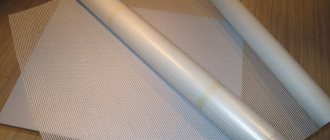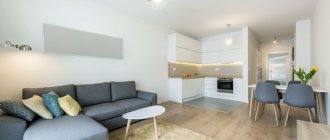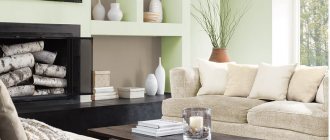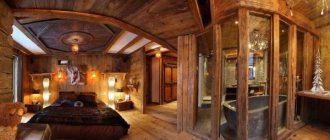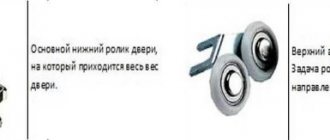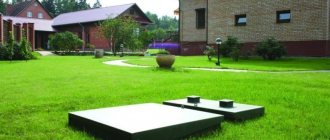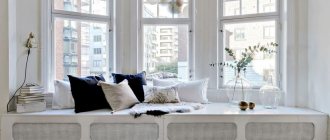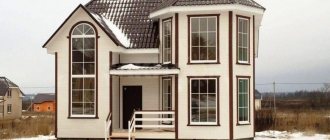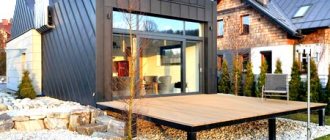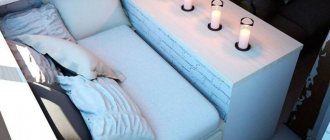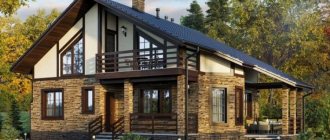If earlier columns in the interior were used only for practical purposes, as a base for the ceiling, roof, or next floor, today the situation has changed dramatically. A modern interior implies not only their functional purpose, but also a decorative one. In both cases, this structural unit has to fit into the interior of the room, and the technique chosen for this may be different and depend on many factors, which we will talk about.
Decorative columns in the interior Source www.stroydodyr.ru
Column located asymmetrically Source landshaftdizajn.ru
Marble column in the interior Source pinimg.com
Concrete column in the interior Source lepnina-oboi.com
Columns in modern rooms
In ancient times, columns served as supporting structures, and only later began to play a decorative role in the interior. The classic column consists of three parts:
- base - or base (lower part);
- trunk (central part);
- capitals (top part).
The bottom and top parts may sometimes be missing. The capital is the most decorative element of the column, decorated with elegant ornaments and regal bas-reliefs.
Modern columns can have the following design options:
- colonnades;
- paired columns (or united by one arch);
- semi-columns.
Paired columns are a classic option. They are usually located on both sides of the fireplace, window or staircase. Installation to opposite walls makes it possible to delimit the space, dividing it into functional zones. If they are united by an arch, this effect is enhanced.
Most often, paired columns have only a decorative function, participating in the design as an element that unites the space into a single zone, emphasizing the overall style.
Colonnades. This type of column is a great way to unobtrusively zone a space. If their location is determined at the construction stage, they can become a supporting structure, also carrying a functional load.
Half-columns - imitate columns protruding from the walls. The role in the interior is actually the same - creating a visual accent, zoning the room. It is very easy to frame a fireplace or window with them, fixing them against the wall, since they do not carry any functional load. They look no less expressive in the interior than traditional ones.
Interior design using columns can dramatically transform a room. With their help, it is easy to make a spectacular accent where it is needed.
Keep in mind that the shapes and sizes of columns significantly affect the perception of space. Tall, thin designs bring more grace to the interior, visually expand the space and increase the height of the room.
Thick ones, on the contrary, can visually make the room smaller. However, they give it fundamentality and create a feeling of strength and reliability.
Materials for columns
If several centuries ago marble, granite and other natural stones were used to make columns, today they are practically not used. The reason was the high price of the material and possible problems during subsequent processing. Stone structures are found in cultural and historical buildings, while other materials are used for the construction of residential buildings.
Decor of gypsum columns Source pinimg.com
Reinforced concrete
Reinforced concrete columns in a modern interior can be presented in various designs: round, rectangular, square. They are made on site using molds, during the construction of a building or in a concrete production plant, after which they are delivered and installed using special equipment. Such structures can remain almost in their original form. A thin layer of putty hides all the defects of the product, turning it into a full-fledged decorative element, which can only be painted or processed in another way.
Reinforced concrete column in the interior Source pinimg.com
Natural wood
Wood in the design of columns can be the main material from which they are made or used as a cladding material. These include ordinary retaining posts and beams. Decoration depends on the style of the room in which these columns are used. In ethnic styles (rustic, Provence, chalet) coloring is allowed; a similar condition applies to modern loft and minimalism. In a classic or other artsy style, wooden columns are decorated with additional decor.
Interior with wooden columns Source kvartblog.ru Wooden columns in high-tech style Source static.wixstatic.com
Columns made of natural wooden beams Source mehomez.com
Wooden beams and columns in the interior Source architizer-prod.imgix.net
Other finishing materials
A fairly broad category, united due to the fact that all the materials included here are not self-supporting and cannot be used as the main material from which columns are made. They are used only for decorative purposes. The most popular are:
- Gypsum stone. It is made from water, gypsum, sand, additives and plasticizers. The final composition may vary depending on the manufacturer. It is used in a variety of forms: imitation of artificial or natural stone, stucco molding, antique patterns, tiles, plaster compositions. The main advantage of the material is complete safety for humans, a high coefficient of vapor permeability, and a simple application method. In most cases, finished elements are glued to the surface of the column in the prescribed order.
- Polyurethane foam. Porous, gas-filled polymer with a durable front surface. It is made in the form of full-fledged wall panels or decorative elements (wall planks, cornices, sandriks, columns, half-columns). The main advantage of polyurethane foam is its low weight, the disadvantage is that it is manufactured according to standard forms. If the column in the interior of the room has a non-standard shape, the elements will have to be trimmed, which may affect their aesthetics. Otherwise, turn to plaster decor.
- Extruded polystyrene foam (foam). Outwardly similar to polyurethane foam, but differs in a number of characteristics. Less durable, since it does not have a protective decorative surface, the cellular structure is prone to destruction under the influence of ultraviolet radiation, is more susceptible to fire, and during the combustion process it emits gas that is poisonous to humans. It is also sold in the form of ready-made decorative elements that are glued to the base of the column.
Healthy! Due to low resistance to mechanical damage, decorative columns are not completely made of polystyrene foam. It is best to line the lower part with a different, more durable material.
- Plaster. The decorative multi-layer plastered surface creates the impression of a three-dimensional image, the sophistication of which will depend on your imagination. With its help, you can recreate not just a magnificent interior, but a real work of art. The most popular application is Venetian plaster.
- Mosaic. The variety of varieties makes it one of the most popular options for decorating columns. To do this, you do not need to buy variations with a pixel size (one cell) of 1x1 cm. You can use flexible types, where the pattern is fixed on a fabric or paper base. In this case, all you need is to cut the elements to a suitable size and glue them to the column with mounting glue.
- Drywall. GCR is a unique material, the shape of which can be changed depending on need. A column finished with such sheets can be rectangular, square, round, or have any other shape. After priming and puttying, it is finished in one of the necessary ways: plastered, lined with wall panels, gypsum, polyurethane, polystyrene foam, mosaic, painted.
The advantage and, at the same time, disadvantage of the material lies in the need to construct a lathing onto which the drywall is fixed. On the one hand, this can be regarded as extra work and a reduction in the area of the room, on the other hand, it is easy to hide communications inside: electrical wiring, ventilation pipes.
Emphasis on imposing columns Source cloudfront.net
Cladding columns with polystyrene foam Source cloudfront.net
Drywall columns Source www.remontbp.com
Healthy! It should be taken into account that thick columns in the interior visually reduce the space of the room, but create the impression of confidence and reliability of the structure. Thin ones will add elegance, expand, and visually increase the height of the ceiling.
Art Deco
A style that combines features of baroque and antiquity, sometimes modern. The shape of the columns must be strict and the lines must be clear.
In the upper and lower parts they can be decorated with gypsum stucco (gypsum will successfully replace polyurethane). If we talk about color, white, the classic version, is preferable.
How do they look in the interior?
In the modern interior of apartments and houses, pillars are rarely found. But if you are the lucky owner of high ceilings and a large area, be sure to add this decorative element to your design.
In small rooms, false columns will come in handy. Thanks to the vertical, they will make the room visually higher, plus they will replace bulky partitions and zone the space.
The use of architectural elements depends on where they are located:
- Living room. They hang a TV, pictures, and install shelves. An electric fireplace will be placed inside the wide structure, and the air duct of a classic stove will be hidden in it.
- Bedroom. They hang a TV and use it to separate the bedroom and other areas. Place a pair on either side of the bed to highlight the headboard.
- Corridor. Install mirrors or hooks for clothes.
- Kitchen. Used as a support under the tabletop, hidden between cabinets. Paint with chalkboard paint to use as a decorative element.
- Children's room. They decorate it like a fairy tree, place shelves and climbing hooks.
The photo shows the design of the hall in a blue palette
Retro
In this case, the finish will be rough, not luxurious. It can be natural stone or imitation, aged wood.
Interior doors in the house - which ones to choose? Review of the best models of 2022. 125 photos of new designs- Entrance doors to the house - which ones to choose? Review of the best models of 2022, design examples + 120 photos
- 8 by 8 house layout - the best design projects of 2022. Instructions for beginners + 100 design photos
Building columns with your own hands
Here are step-by-step instructions for building columns for your home with your own hands.
- Initially, wooden formwork of the appropriate size is selected and assembled on the base. It is better to buy special formwork for columns, or you can make it yourself if experience allows.
- As a rule, the columns are quite high, so the shields are assembled to a level of 1 meter on all four sides, then only on three. The fourth is increased during the pouring process.
- The formwork panels are placed strictly vertically with a mandatory level check, and secured with special locks. To ensure stability and maintain a vertical position, the formwork is strengthened with struts, which can be purchased at a hardware store. As a last resort, it is permissible to use wooden spacers with stakes.
- After installing the formwork, a metal frame is placed inside it. If an increased load on the column is planned, for example, it will be used as a central support for a house, it is necessary to carry out an accurate calculation of the structural elements. An example of a house design with columns that are used to support the roof over the entrance
- Columns use quite a lot of reinforcement, so the concrete must be mobile to fill the voids between the elements of the reinforcing structure. Mostly they use material with mobility P-4.
- It is recommended to lay concrete in one step to avoid cold joints in a monolithic structure. If this is not possible, such a seam must be located in a horizontal plane, otherwise such a column will not last long.
- Concrete is laid in even layers in one direction, compacting it using a vibrator or metal rod. When concreting, it is necessary to ensure that the reinforcement structure is located strictly in the center.
- If the project’s column is installed in the center of the house, it must be anchored to the floors. An example of formwork for pouring a column with built-in anchors
- When using a column outside the house, anchor bolts are used to fasten the structure to the foundation and the floor resting on it.
- The formwork is removed only after the concrete has completely set.
High tech
This style requires unexpected and original ideas. For example, futuristic ones: illuminated glass columns that are filled with liquid with air bubbles moving upward.
The main recommendations are to use metal, create shiny surfaces that reflect light.
Examples of interiors with columns
If properly designed, columns can become a sign of the greatness and wealth of a family, as they are elements of a majestic palace style. However, an inconvenient location and errors in the choice of style and finishing material can lead to the fact that they will turn into a structure that will only occupy free space and nothing more.
Kitchens
Let's look at several original options for cladding columns in the kitchen interior using photographic examples. It is possible that one of the presented methods will be suitable for your interior.
Large living room with columns in the interior Source dekormyhome.ru Metal column in the living room Source www.remontbp.com Column with plaster stucco for the living room Source www.v-interere.ru
Columns in a living room decorated in antique style Source akuhnja.com Columns zoning the living room area Source media.interiorexplorer.ru
Loft
Clear square and rectangular shapes would be appropriate here. Imitation of brickwork and concrete, rough plaster are suitable for decoration.
- Advantages and disadvantages of metal siding
- TOP 5 popular myths about plastic windows
- We are building a house, what should we pay attention to?
Era? Style? Direction?
Noble classics
The classic interior with antique columns is based on Greek samples - Doric, Ionic, Corinthian styles. The decoration of the base, body, capitals not only has not changed, moreover, good taste requires strict adherence to Greek ideals.
Antique Greek columns and half-columns are harmoniously combined with modern multi-level ceilings, lighting, and polyurethane stucco molding. Decorating columns with Venetian plaster, marbled painting, and natural stone is widely used by decorative artists. Columns are made from inexpensive materials - polyurethane foam, gypsum, concrete, and then richly painted. This significantly reduces their cost and simplifies installation.
Modern designers especially liked the combination of two or more columns connected by an arched bend. Arches, in order to reduce the cost and lighten the structure, are made of plasterboard. The same style includes rectangular wooden columns, decorated with expensive types of wood in the style of an English office or a Russian mansion, together with wooden panels on the walls.
Mysterious east
Impressive colonnades connected by arches are an integral element of oriental architecture. In contrast to classical restraint, the body of the eastern column is richly decorated with mosaics, ornaments, and bright colors.
Arched curves are emphasized by additional lines and are also richly and brightly lined. Architectural ensembles with columns in oriental interiors are complemented by fabric draperies, carpets, and stained glass windows.
Modern interior trends
Minimalist style, hi-tech, loft – the columns have not been spared. These styles require large free space and significant height. The columns here act as floor supports. Most often, these are simple pillars, finished in accordance with the style of the room - metal (silver, nickel, chrome, copper), clinker “looking like aged brick,” concrete with traces of formwork. The latest trend is the use of lighting in glass columns with bubbles.
Country styles
In the good old Provence, Russian rustic style, and other ethnic styles, wood and rough natural stone are preferred for decorating columns. Columns can be entirely wooden, and “stone” finishing on various bases (concrete, polyurethane foam, plasterboard, false column) is done with materials that imitate stone.
Using half-columns, columns, decorate them based on the style of the entire room, and any, even the simplest stand, will become a “highlight”.
Interesting design ideas
In order for the column to successfully blend into the setting, becoming part of the whole picture, sometimes creative solutions are needed
- current technique is a combination of rough stone finishing with soft materials;
- columns installed nearby can easily be converted into a homemade shelving unit;
- using columns, you can create a niche to place a TV or music center;
- with properly equipped lighting, you can highlight a decorative niche inside where a painting, antique dishes or sculpture will be located;
- You can delimit the space even more effectively by placing a cabinet or rack between the columns.
Use your imagination to use this interior detail as profitably as possible. Modern possibilities allow you to decorate your home based on any taste preferences.
In what style can it be used?
Columns in the interior of an apartment are used in a variety of styles - from classic to ultra-modern.
Classic. The epithets that characterize the direction are elegance, richness, sophistication. Stands made of natural or artificial stone, gypsum, or polyurethane are suitable. Finishing with decorative plaster and decor with stucco look appropriate. Using a flexible stone, create an imitation on any source material, this will help save on decor.
Oriental. More often they place not a separate column in a room, but several at once, uniting them with arches. This type of colonnade replaces missing partitions in studios and other open spaces. In the East they love luxury, so you shouldn’t skimp on decoration. Decorate with mosaics, fancy ornaments, flowers, gold.
Loft. High ceilings, large open spaces - columns just beg to be included in the interior. To make the room look as industrial as possible, the structures are made of concrete, brick or metal, without finishing them with any decor. The shapes and lines are also simple, the cross-section is square or round. A black I-beam channel made of thick metal looks original as racks.
The photo shows a modern dining room in an apartment
High tech. In the traditional sense of style, there are no columns in the apartment, but if they are already provided for by the architect, decorate them with modern materials. Chromed metal is best, but glass, backlit panels or futuristic “aquariums” with air bubbles will also work. Lava panels that look like a large lava lamp are available to order.
Country. The rustic style prefers wooden decorative elements, and the decoration of columns is no exception. The pillars look different: a neat cylindrical beam, a rough, irregularly shaped trunk, a semi-column made of painted boards.
Baroque. Pompous, luxurious antique design does not accept half measures, so columns in the room are preferably made of natural stone, mahogany and other expensive materials. The uniqueness is emphasized by the complex decor of the capital; to highlight this element, add lighting from below.
Modern. The direction is distinguished by asymmetrical shapes and curved lines. A custom-made structure will become the hypnotic center of the entire home. Floral patterns and repeating patterns are welcome as decoration.
Species and types
The shape of a concrete column can be: round, square, rectangular, which is determined by the cross-section of the support.
According to production technology:
1) Prefabricated concrete columns - produced at the factory, transported to the site, relatively inexpensive, provide quick installation, high speed of drying of the solution.
2) Monolithic columns - poured into molds directly on site. It is possible to control the quality of laying the solution and the flow of the mixture. But the production of such structural elements requires a lot of labor and time, and is quite expensive.
When choosing the type of column, it is very important to consider the type of marking of the finished reinforced concrete product of this type.
Column markings:
- T1 – for fixing concrete consoles installed perpendicular to the main columns.
- C1 – for the installation of lattice connections.
- L1 – for the installation of flights of stairs with three flights.
- L - stairs are connected with two flights.
- P - used in places where it is necessary to create a column under a crossbar (installed where there is a rotation of the general frame).
- SS – support with 2-4 edges for high-quality fastening of the rigid walls.
- C - for fastening various panels in contact with the reinforcement walls.
- T – concrete columns at the ends of building enclosing panels.
Disguise
This technique will help when the columns in the interior of the room occupy an inappropriate place, that is, it cannot be used for another purpose (dividing the space, displaying it as an elegant element that emphasizes the stylistic direction, using it for another purpose). In this case, there is only one way out - to make it as less noticeable as possible against the general background. There can be several methods for this:
- Lined with mirrors, it will blend in with the rest of the interior and will not be so conspicuous.
- Finish with the material used for the walls.
- Hide behind a curtain, curtain, screen. This can be easily accomplished by choosing a volumetric material suitable for the interior.
Advice! The technique is most often used to “hide” one column. Carrying out a similar procedure with two or more can be problematic.
Zoning
If positioned well, a decorative column can be used as a space delimiter into zones with different functional characteristics. This method will have an additional number of advantages , which were already mentioned earlier:
- The columns do not obstruct the light coming from the windows.
- They do not occupy free space in the room.
- They free the space from the clutter of partitions, making it more spacious and bright.
Accenting
Use as a decorative element is an excellent option for how to use columns in the interior. There are many ways to implement your plans. The basic rule is to choose the right material and method of cladding that blends favorably with the rest of the room’s design.
One of the options for executing the plan could be decor using finishing materials and attracting attention with the help of artificial lighting.
For example, install a lamp at the bottom or top of the element. The only thing that needs to be taken into account is that the light saturation should not be excessive. It is not necessary to illuminate the entire surface of the column; it is enough to direct the beam at one of the protruding faces.
This technique is beneficial regardless of its shape, rectangular or rounded.
Practical use
In addition to aesthetic functions, decorative columns can also play a practical role. In particular, they are easy to adapt to specific needs, combining beauty and style with needs. There are many options for execution. Let's look at a few of the most popular solutions:
- Use it as a place to place the TV.
- Organize a magnetic or slate board on it, which will be useful to every family member, and especially children.
- When the column is located next to the wall, away from the passage area, it can be used to easily fix the hammock. This method will turn this area of the room into a full-fledged place to relax.
In a similar way, you can use it as one of the points for supporting the fastening of other built-in furniture (kitchen island, bar counter, dining table).
- Arrange a plasterboard structure around it and make niches for storing books, photo frames and other decorative elements.
Important! The need to construct support columns most often arises during the construction of a large country cottage. In this case, you can take care of the location problem in advance and build the project in such a way as to use them profitably in the future.
